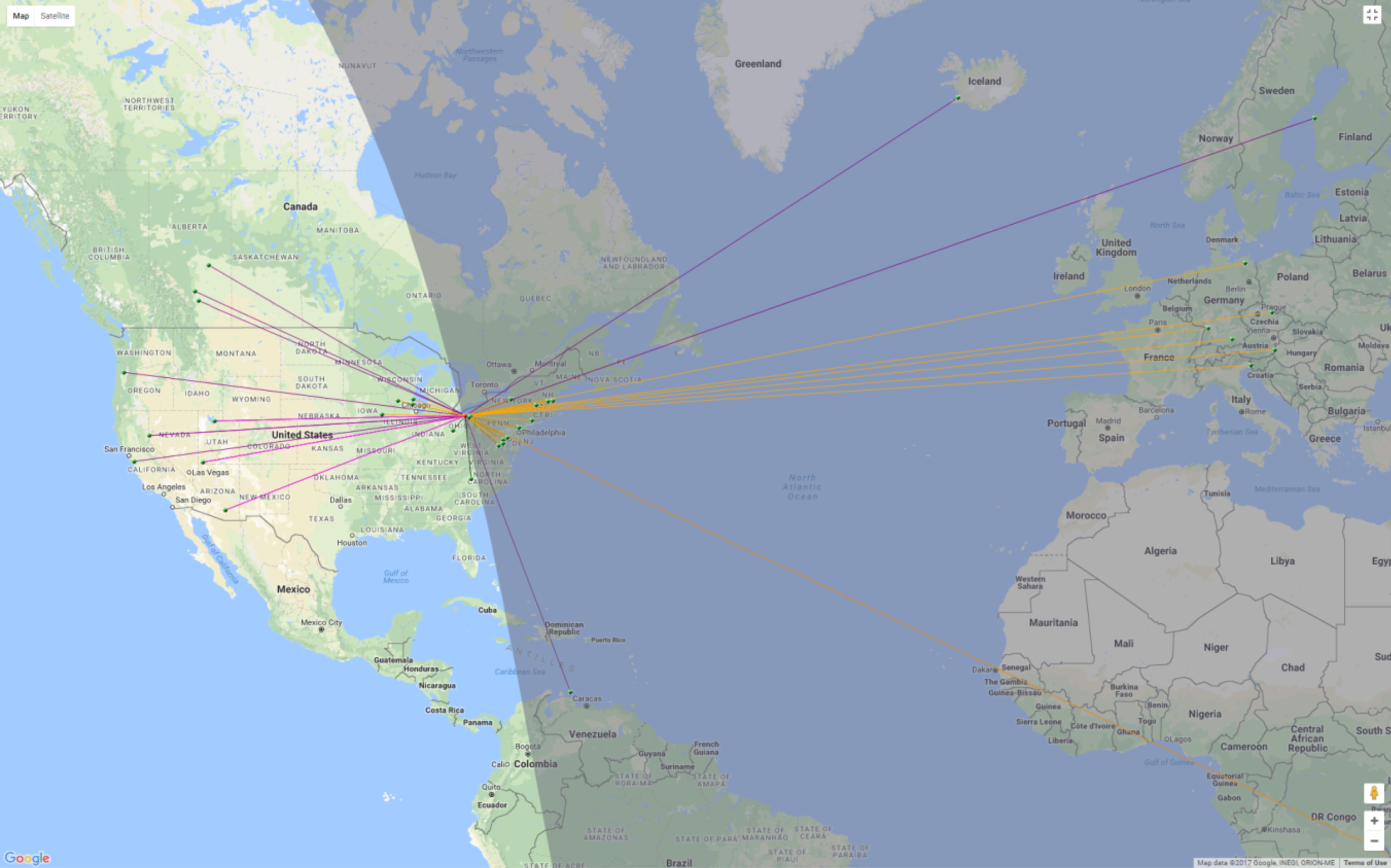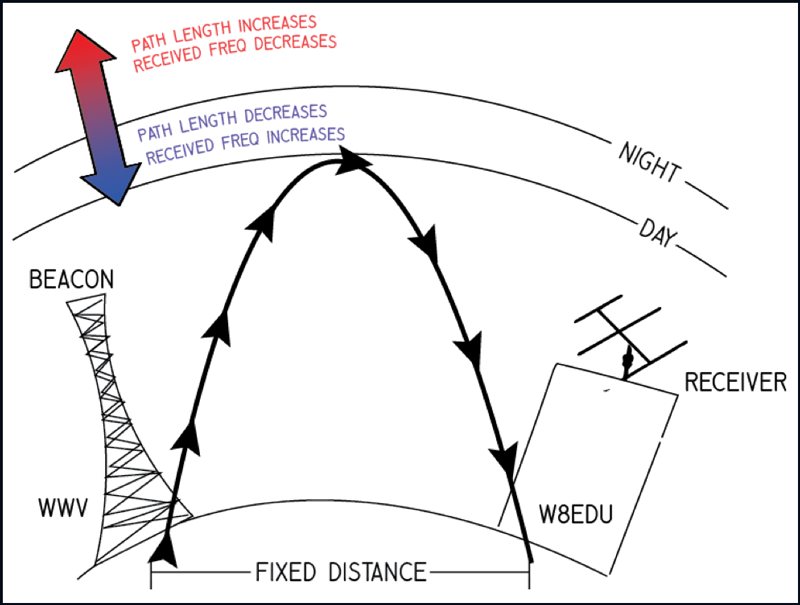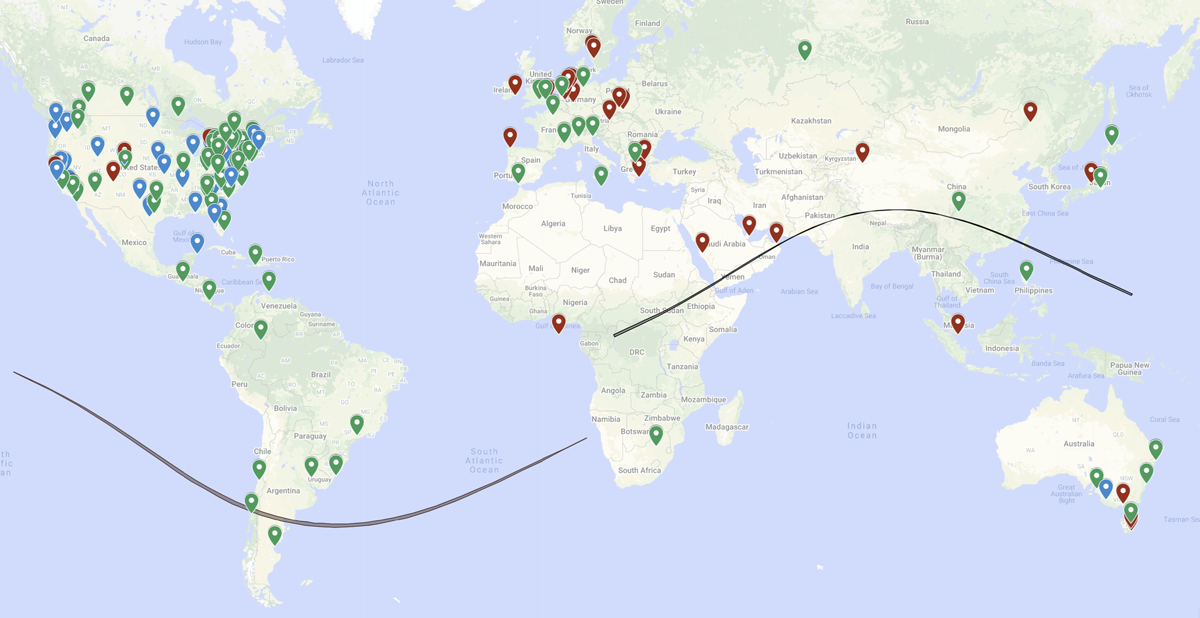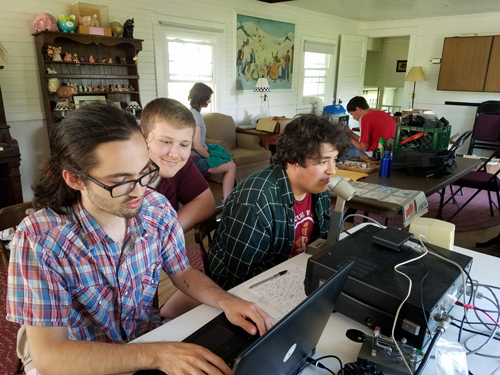Space weather events, triggered by solar emissions and their interactions with Earth’s atmosphere, can have significant effects on communications and navigation technology and on electric power systems. As with terrestrial weather events, the economic impacts of space weather–related disruptions can be substantial, affecting satellite systems as well as systems on the ground. A severe geomagnetic storm (on the order of the Carrington Event of 1859) could have a catastrophic effect on modern infrastructure. Even solar storms of more ordinary size can induce currents in the power grid that drive up energy prices, affecting manufacturing and commerce.
Considerable interest exists in developing space weather forecasting technologies that use Earth’s ionosphere as a sensor for events in its neighboring atmospheric layers. The ionosphere occupies a privileged niche in the geospace system, as it is coupled into both the terrestrial weather of the neutral atmosphere below and the space weather of the magnetosphere above.
Although we have a good understanding of ionospheric climate—diurnal and seasonal variations are well known, as are the rhythms of the sunspot cycle—there are new and vital areas of research to be explored. For example, it is known that the ionosphere—and near-Earth space—experiences variability (e.g., radio signals can fade in and out over periods of seconds, minutes, or hours due to changes in ionospheric electron densities along signal propagation paths), but this variability has not been sampled or studied adequately on regional and global scales.To fully understand variability on small spatial scales and short timescales, the scientific community will require vastly larger and denser sensing networks that collect data on continental and global scales. With open-source instrumentation cheaper and more plentiful than ever before, the time is ripe for amateur scientists to take distributed measurements of the ionosphere—and the amateur radio community is up for the challenge.
The Ham Radio Science Citizen Investigation (HamSCI) is a collective that unites amateur radio operators with the research community in the space and atmospheric sciences. This confederation of scientists, engineers, and hobbyists holds annual workshops during which ham radio operators and space scientists share findings. A new HamSCI effort, the Personal Space Weather Station project, aims to develop a robust and scalable network of amateur stations that will allow amateurs to collect useful data for space science researchers. The next HamSCI workshop will be held virtually 19–21 March 2021, and it will focus on midlatitude ionospheric measurements.
A Ready-Made Volunteer Science Community
From a communications point of view, the electromagnetic spectrum is a finite resource. Signals from broadcasting, telecommunications, and navigation all have their own demands of bandwidth and range. Spectrum allocations are managed by government agencies, such as the Federal Communications Commission (FCC) in the United States. Most countries allot some of the available spectrum to amateur users for the purposes of recreation, experimentation, and the promotion of international goodwill. There are more than 760,000 licensed amateur radio operators and uncounted shortwave listeners in the United States alone.
Amateur radio operators have an empirical knowledge of space weather because they want to know when and on what frequencies they can establish communications—and when and where they cannot. Changes in the ionosphere like those caused by the day–night transition or by solar activity can impede or aid communications on various frequencies. For example, the 20-meter band (14–14.35 megahertz) usually has its longest transcontinental reach during daylight hours, but the 40-meter band (7–7.3 megahertz) often works best at night. Amateur radio frequency allocations are distributed throughout the electromagnetic spectrum, enabling useful propagation experiments for any frequency range.In the pursuit of the hobby, many an amateur operator (or “ham”) has experienced hearing the high-frequency (HF) bands (3–30 megahertz) go quiet right after sunset or has swapped frequencies to reach a distant station. Hams greatly value forecasts of space weather conditions and real-time information about propagation, and the community has a high level of scientific literacy on the topic. Resources like spaceweather.com and a weekly podcast by Tamitha Skov (the “Space Weather Woman,” whose amateur call sign is WX6SWW) are regularly consulted today by hams looking to achieve a distant contact.
Ham radio is currently experiencing a technical renaissance, thanks to the advent of inexpensive single-board computing platforms (a complete computer built onto a single circuit board, such as a Raspberry Pi) and open-source software. Such computer-based systems serve as virtual radio repeaters, connecting computers via the Internet to actual ham radios in the real world to enable remote control and data collection. Beyond the old-fashioned pursuit of voice communication, the lure of maker movement projects and the removal of the Morse code requirement from the amateur licensing exam have led to a greater number of licensed amateurs than ever before.
Out of this increasing technical sophistication, digital communications networks, such as the Automatic Packet Reporting System (APRS), the Weak Signal Propagation Reporter (WSPR), and the Reverse Beacon Network (RBN), enjoy wide membership and serve the amateur community while collecting propagation data at rates and resolutions that were previously impossible. The reach of these crowdsourced systems, and the support of the amateur community, offers tremendous opportunities for scientific measurements.One such measurement took place at sunset on 17 October 2017, when amateur station W8EDU in Cleveland transmitted the Morse code for “TEST TEST TEST DE W8EDU W8EDU W8EDU” on frequencies in the 20-, 40-, and 80-meter bands. A map of the automated listening stations in the RBN that picked up, or “spotted,” this signal shows all of the spots with extant propagation paths (Figure 1). In this case, the result clearly shows that the 40-meter paths go primarily to the nightside of the terminator (the moving boundary between regions in daylight and those in darkness), and the 20-meter paths primarily to the dayside.

For amateur operators, this is a useful tool for determining the reach of one’s signals: A ham might say that “there’s a path into Europe opening up on 40 meters” and listen for the call signs of European stations. Or, if operators want to reach a station in South America, they might rotate their antenna by 90° and try running an RBN test again.
Harnessing the Data for Science
How can ham radio signals tell scientists about energy and particles originating in the Sun and traveling millions of miles through space? The answer lies in the ionosphere, the electrified atmospheric region that can refract radio signals back to Earth. This is a complex region heavily influenced by the solar wind, extreme ultraviolet ionizing radiation, and geomagnetic disturbances, and even by the lower and middle neutral atmosphere.
From the perspective of scientists studying the ionosphere, ham radio data become most interesting in aggregate. All the data in the RBN, from 2009 to the present, are archived at reversebeacon.net and can be freely downloaded. For scale, the earlier-referenced Cleveland transmission represented only a small subset of the 168,713 radio spots that were recorded on 17 October 2017, each one representing a propagation path between two points on a given frequency at a given time.
HamSCI encouraged amateur operators to generate data on the RBN during the North American eclipse of 2017. Later analysis confirmed that the RBN data were consistent with physics-based ionospheric models [Frissell et al., 2018], indicating the promise of this system for collecting propagation data.A further advantage of collecting data through the amateur community is that these observations tend to naturally fulfill the requirements of FAIR data: findable, accessible, interoperable, and reusable. Amateur operators are prohibited by the strictures of licensure from earning money through the act of operating, so most data used by operators are open and accessible at their creation. Because much of the amateur community is technically literate, databases and records are structured around machine readability. Most important, amateur radio has a global and persistent identifier woven into the metadata of every recorded contact: Each licensed operator or club has a unique call sign, tied to a physical address in its respective government database.
“At the Tone, the Time Will Be…”
Just outside Fort Collins, Colo., lies the heartbeat of the electromagnetic communications spectrum—and one key to precision measurements of the interactions between ham radio and solar weather. The sound of radio station WWV, the time and frequency standard of the National Institute of Standards and Technology, is familiar to any shortwave listener. It is the oldest continuously operating radio station in the United States, having been on the air since 1919. Today WWV and its sister station WWVH in Hawaii broadcast the familiar “At the tone, the time will be…” message on 2.5, 5, 10, 15, and 20 megahertz, with the frequencies calibrated to at least nine significant digits.
These stations supply listeners with standardized time information, high-seas weather forecasts, and other programming. Station WWVB, located at the same Colorado site, transmits on 0.060 megahertz and provides timing information to radio-controlled “atomic” clocks. In recent months, WWV’s precise, cesium-controlled carrier has found another use as a beacon for ionospheric measurements.
Radio signals provide a window into the changing ionosphere. The various signals from WWV, reflecting off the ionosphere, undergo changes in path length as the ionospheric electron density profile changes. This results in changes to the observed frequency of radio signals at receiving points, akin to the rise and fall in pitch of a passing train whistle.

Comparing the received radio signal with a precision local frequency standard, such as a GPS-disciplined oscillator, allows a user to measure these ionospherically induced frequency shifts (Figure 2). This measurement is prepared and recorded with open-source software. Numerous data sets recorded simultaneously from multiple locations offer information—when these data sets are examined both individually and collectively—about the ionosphere at the time the data are taken. This information includes the movements of traveling ionospheric disturbances and other important phenomena at various scales.
The Festival of Frequency Measurement
On 1 October 2019, HamSCI celebrated the centennial of WWV with a Festival of Frequency Measurement. HamSCI issued an open call to amateur radio operators and shortwave listeners to gather Doppler shift data, and about 50 stations responded (Figure 3). We presented the results of this experiment at AGU’s Fall Meeting 2019 [Kazdan et al., 2019], and the data from the experiment are freely available. These data are rich with signatures of ionospheric dynamics, including coherent wave-like disturbances with periodicities at night of about an hour. The observations are more quiescent during the day. The results will also be summarized in an upcoming paper in IEEE Geoscience and Remote Sensing Letters.

WWV was never intended to provide these data, but the station’s exceptional precision, high power, and guaranteed continuous availability make it a perfect beacon. Thanks to the advent of inexpensive GPS-disciplined oscillators and single-board computers, amateur scientists can assemble complete prototype systems to collect such data for less than $200, or they can build systems from existing equipment. Thus, the amateur community, mobilized on a national scale, can generate a large-scale, novel data set for ionospheric study.

Data collection campaigns during the solar eclipses of 2020 demonstrated the potential for scientists to engage with the amateur community. Dubbed the Eclipse Festivals (Figure 3), these events followed the template of the WWV centennial event on a global scale, using 10-megahertz time standard stations. The June 2020 Eclipse Festival, built around the annular solar eclipse across eastern Africa and Asia on 21 June, ran for 3 days and included volunteer participation from 50 stations in 19 countries. The December 2020 Eclipse Festival, a 7-day campaign built around the total solar eclipse across South America on 14 December, drew data submissions from over 80 stations. Both were advertised through the same channels used for radiosport contests and other events. The strong participation in these events demonstrates the community’s interest in community science and the potential for deployment in science campaigns.
Making Space Weather Personal
The personal weather station has become a familiar fixture for meteorologists. Stations belonging to hobbyists, networked through sites like Weather Underground, provide a dense constellation of sensors reporting air temperature and pressure as well as precipitation. We have better knowledge of terrestrial weather because of these networks, but no such system exists yet for ionospheric weather.
Through HamSCI, ham radio operators and researchers are bridging this gap by designing hardware for a distributed network of personal space weather stations (PSWSs), accessible to professional and amateur scientists alike. These stations come in two varieties (Figure 4): a low-cost model designed only for observations like those performed during the Festival of Frequency Measurement, and the more powerful, software-defined radio TangerineSDR, a wideband receiver that can be reconfigured for a range of experiments. At the core of both is a single-board computer, which interfaces with a set of modular instruments (e.g., a magnetometer) and uploads data to a central database.

These stations are in the prototyping and testing stage, with plans to deploy a network of PSWSs in the next 3 years in time to record the upcoming 2024 solar eclipse across North America. As the Moon’s shadow travels across Earth’s surface, it will shield the radio stations below from solar extreme ultraviolet radiation, providing an excellent opportunity to collect baseline radio data. We hope to have the network up and running in time for Festival of Frequency Measurement 2024, and we invite hams to join in as volunteer scientists to help improve our understanding of Earth’s space environment.
Acknowledgments
This research is supported by National Science Foundation grants AGS-2002278, AGS-1932997, and AGS-1932972. The authors thank all HamSCI collaborators, particularly those at the Tucson Amateur Packet Radio Association, MIT Haystack Observatory, the University of Scranton, the New Jersey Institute of Technology, and the Case Amateur Radio Club (W8EDU).
"network" - Google News
February 09, 2021 at 08:31PM
https://ift.tt/3rAZM3C
Ham Radio Forms a Planet-Sized Space Weather Sensor Network - Eos
"network" - Google News
https://ift.tt/2v9ojEM
https://ift.tt/2KVQLik
Bagikan Berita Ini














0 Response to "Ham Radio Forms a Planet-Sized Space Weather Sensor Network - Eos"
Post a Comment